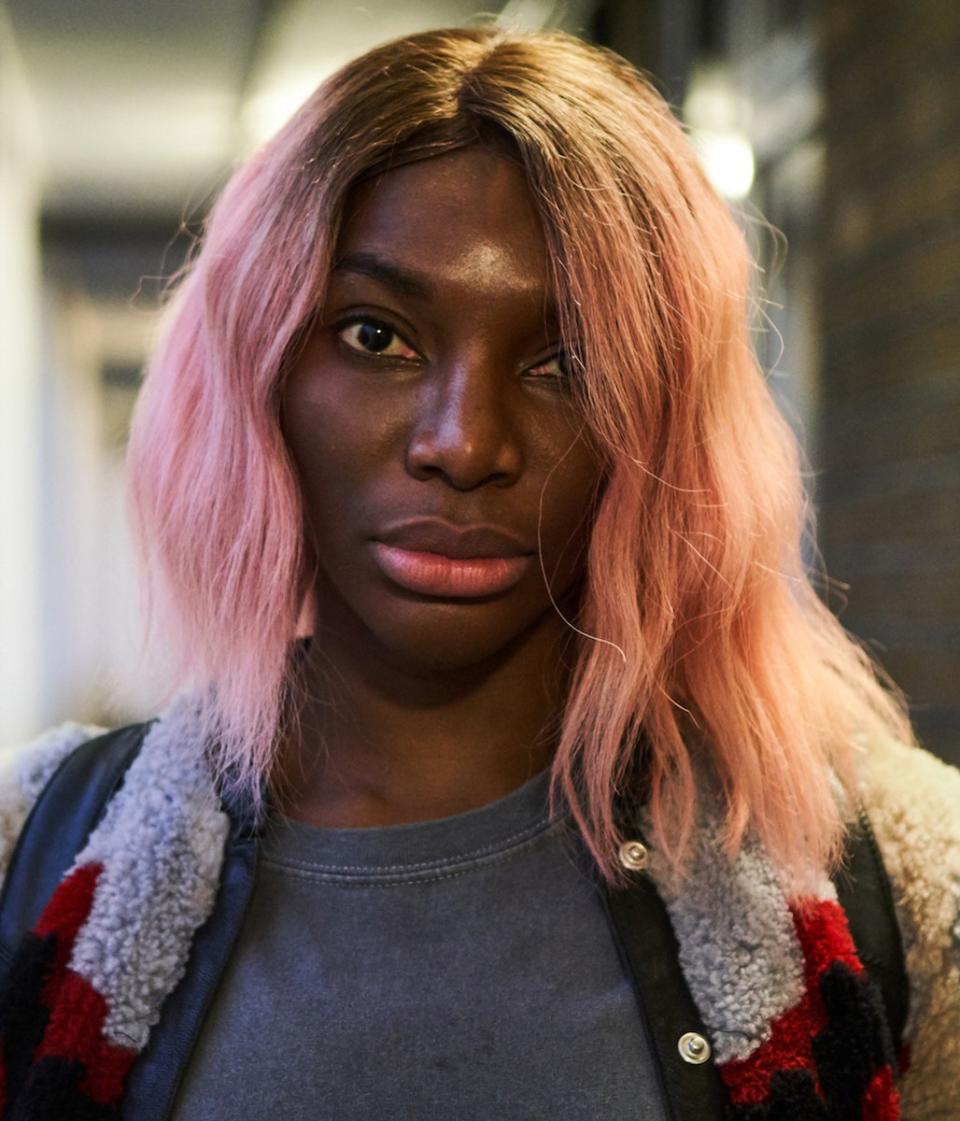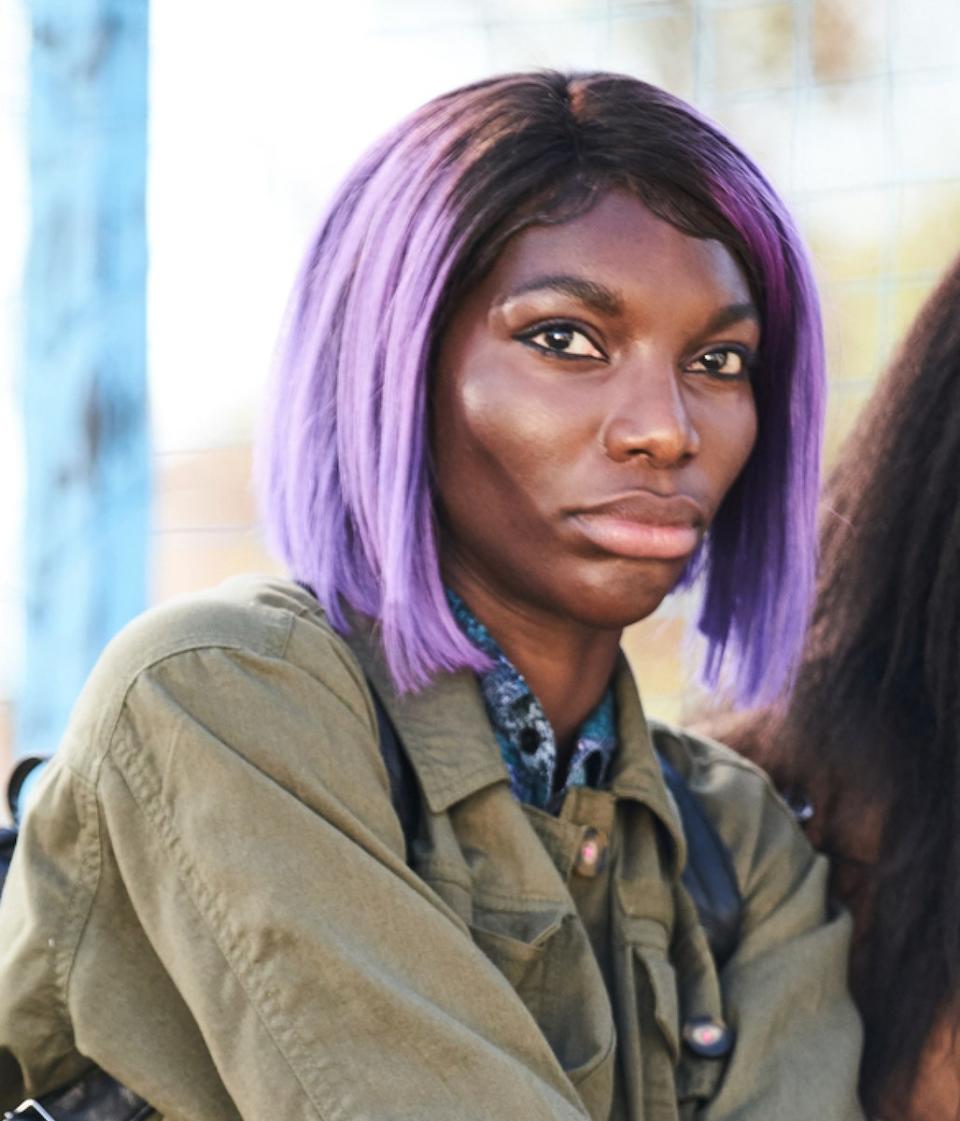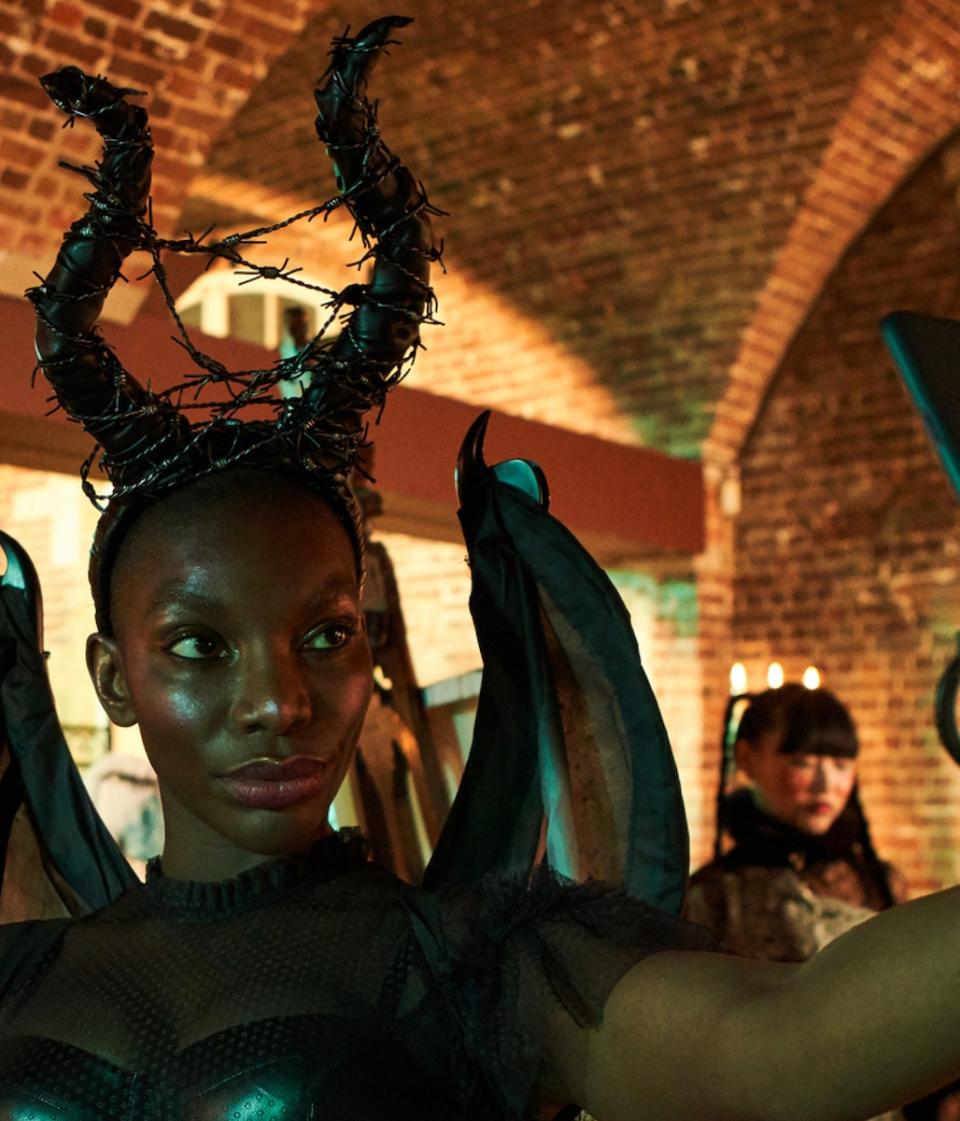How Michaela Coel’s I May Destroy You Creates Character Through Hair
Here's the lowdown on how to subscribe to Allure's print edition for more beauty routines, recommendations, and features.
The first scripts for HBO’s I May Destroy You describe Arabella, the series' main character, portrayed by writer and director Michaela Coel, as “early 30s, Black, pink hair.” When viewers are introduced to her, her hair is a sun-washed shade of cotton candy, or a piece of bubble gum clinging desperately to the last of its sweetness.
From Arabella's introduction forward, the show’s timeline is chopped, flipped, and reversed, mirroring the character's disorientation as she uncovers the details of her own sexual assault throughout the season. (The show is inspired by Coel’s own experience dealing with a similar assault.) A wardrobe of wigs, explains Bethany Swan, the makeup and hair designer for the show, helps the audience identify the myriad tone shifts in Arabella’s internal monologue. We see what she looks like at the very apex of her self-esteem when her hair glows a molten lavender. Then we see how she’s changed, and how she hasn’t, from scene to scene, even before a single line is spoken.
Allure talked to Swan to explore her work in shaping the presentation of I May Destroy You's main character. This interview was condensed and edited for clarity.
Allure: Can you talk about how a character is developed through these hair and makeup gestures?
Bethany Swan: I'm still quite new in the design world, but it's been incredible to create characters and use hair and makeup as the story. I love backstory. I love looking at someone on the tube, on the street, and wondering why they look like that, where they're going. Is that their normal look and stuff? And to be able to portray that on the screen, to make people feel more real, it's just been an absolute pleasure.
Obviously, you read the scripts and costume is a huge part of the character. So I usually go to costume, find out what they're thinking and what their options are. Then I coordinate the hair and makeup to go with or complement a well-rounded character. It's a really cohesive process, working with those departments. And it's one of my favorite bits because you just get to imagine the person and go from there and build her: What would they wear? What works? And then you can go back to the producers-directors, and Michaela [Coel], in this case, and say, "This is what we're thinking." It's a narrowing-down process from there.
Allure: How did you end up working on I May Destroy You?
Swan: It was genuinely a job interview for me. They liked my mood board, and we just went from there. I've lived in London about 16 years, and for me, it was a really exciting prospect to be able to put my love note, my interpretation of a Londoner, onscreen.
I made mood boards for each of the characters. I love to put it on a page. If, for example, I don't know who the actor is, I make sure I [include] every ethnicity, every hair type, because I don't want to assume any roles, unless I'm aware of who they're looking for.
The only thing that was scripted in the original was that Arabella was a Black girl with pink hair. [At first], I had gone a lot more down the natural hair route because I wasn't sure what length Michaela's hair was — if it was longer, then we obviously had to bleach it, dye it pink, all of this kind of stuff. I did a lot of mood boarding with different lengths of Afro hair in different styles and manipulations. It was important to make sure I [wasn't] going, "Hello, I'm a white designer! Here’s some European hair.”
And I walked in, and Michaela had a shaved head! As the scripts progressed, there were hair changes, and because we were still filming them higgledy-piggledy — different episodes at different times — it just ended up being a wig. It was much easier, to switch in and out, to keep the color. But we wanted to make sure it looked like it was supposed to be a wig, hence the straighter texture. It wasn't supposed to ever [resemble] her natural hair.

Allure: Can we talk more about how you settled on the pink wig?
Swan: “Pink” was the starting point, but that’s a very broad spectrum. You can have shocking pink, pale pink, pretty pink. We went for quite a washed-out looking [option]: We put in roots because we wanted it to look lived in, loved, and also well-used and just a little bit faded; because when we first meet [Arabella], yes, she's got a book deal, but she's seeing a guy she probably knows she shouldn't see, she's struggling, she's got writer's block. To her fans and social media, everything looks great on the outside, but at the same time, we know that she's going through it. Most of the trauma that happens to her happens while she's wearing that wig. We didn't want it to feel too pretty.
I know a colorist that helps me out, so we took it to them and they did a fantastic job. The wig we had was actually blonde, and we put everything over-the-top. We tried bleaching up and it was too orange, and it just didn't give a good base. So we had to go blonde and go dark. [Laughs] I'm a little bit hated for having to do those roots, but it was just really kind of beautiful because the roots gave a slight ash tone over the pink that really worked. When we were discussing [it] with Michaela, we wanted something that didn't necessarily complement her skin tone and felt a little bit jarring, so her skin didn't look the amazing, vibrant color it normally looks. It just knocks it down a little bit.
Once we knew we were going with a wig, I put together loads of different options that I thought would work with Arabella's personality. [Whether] the length [or] the wave, everything was considered; it's not a bob, it's not too long. She's quite blasé, quite chill, and has a great sense of style. We wanted it to be that middle length. Either it's grown out or it's been cut — just a cool, abstract length.
It's quite blunt, so there's not really any particular style in it; really, the person who wears it acts quite free-spirited, which we know Arabella to be. Also, I didn't want it to look too styled, so we've got a soft wave in there. But again, it's not pretty, it's not curly, it's not too straight. It just needed to feel like it fitted with her because she wears all of these beautiful, vintage pieces together and things clash in a really lovely way.
Allure: Let’s talk about specific hair looks, like the vibrant purple wig Arabella wears when she meets boyfriend Biagio for the first time in Italy.
Swan: Again, everything started with discussions with Lynsey [Moore], our costume designer, and Michaela. Not only was Michaela writing and directing, she was also starring, so I was lucky enough to have her in my chair every morning and we could discuss what we were thinking. We knew we had pink, and we knew it was more faded, and, as I said, [reflective of] the more confused, writer's block period of time in Arabella's journey. We wanted this [look] to feel completely different, so we went for the brightest, most unapologetic color we could find.
She's just gotten a book deal, she's in Italy on expenses, her best mate comes out, they're partying, and she's having a lovely time. That is Arabella at full confidence, and we wanted the hair to say that. We put roots in it again to ground it, so that it really belonged to her; I think if we'd done that color all over it would have disconnected slightly. I do love a root. I love just grounding it to the person to make sure that it feels like they own it, and that the wig isn't wearing them. But yeah, so we settled on purple. We were thinking of Dairy Milk [a Cadbury chocolate bar with a bright purple wrapper], being the purple in England. And then we found the color—a [Goldwell] Elumens color—and it was just perfect for it. Up close it's almost pearlescent—it's almost got a blue to purple tone, so it really lives in light.

Allure: For [best friend] Terry’s birthday, Arabella has a brand-new look—basically a sheet of sleek, pin-straight black hair.
Swan: It was scripted that Arabella was wearing a lace wig [here]. Originally, we were thinking it was always long hair, and we went from that real poker-straight [look] to these smoother, watery waves; but we tried it on with the outfits and it just didn't feel right — it felt too soft, so we went back to straight. This wig was a natural black, and it just didn't feel intense enough, so we dyed it properly black-black. I have to apologize to this wig, because to make it really glassy, I oiled it and straightened it to the point that it was probably crying. I really wanted that sheen. I would never recommend doing it on your own hair, but I was argan-oiling and then straightening to really soak. And it just turned to glass. It was beautiful. I regret nothing. But I wouldn't do it on somebody's head.
A lot of this episode is the party at night, so we wanted to get that nice gloss on it. Arabella's clothes aren't really her normal style [here]; she's trying out another persona. So it's a much more Instagram, selfie thing, and that's when you see her doing all her selfies and stuff. The hair needed to feel quite un-Arabella, in a way.
Allure: Are most of these hair cues written into the script at the beginning?
Swan: Not necessarily at the beginning. There was a lot of progression in the scripts from when I first came on. But most of them… The hairdresser scene [when Arabella decides to shave her head], for example, was originally going to be a hair color change. But as we went the wig route, we decided that it would be cool to have it cut up because Michaela looks incredible with it completely shaved off, so why not show it?
It can be cathartic, shaving your head, but in this case it was almost a catalyst. Arabella goes on to speak out against Zain [her writing coach] and confronts her healing process head-on. From this point of the series, we see a different Arabella, all coming to a head on Halloween (episode nine), which becomes a play on a dark angel character. I love how the shaved head completely changes Arabella's silhouette: powerful and strong, but it can be vulnerable and exposed in equal measures.
This is a 5 [⅝ of an inch] trim — we did it and the camera tests and she just looked incredible with it. We shaved it every three days for six months. It was also very practical, because it meant quick wig changes if there was no hair underneath.
In episode 12, there's another wig — a blonde, short wig. I opened my box of wigs that I already had so we could try on a load of stuff. We didn't want to associate [this look] with Arabella because it is supposed to be something she's got as a disguise. And she sort of pulls it out of her little backpack that she always carries with her, so it had to fit in a small bag and not look ridiculous when pulled out.
It's quite a good brash blonde. I had it in my kit because I bought it when we were looking at doing a pixie crop on a character in another project. I put it on [Michaela] and it looked so cool. We were like, "All right, this is the one." And then, yeah, we just wanted it to not feel like any characters that Michaela had done before or any personalities that Arabella had shown through hair. It covers the eyebrows and it's like a bowl at the front, but then it's just a crop in the back. I think that's the only one I cut myself.

Allure: I'd love to learn a bit more about how a white designer is able to come to this and tell such an authentic story. I imagine a fair amount of it comes from others on the show, including, of course, Michaela. But I'd love to hear about any education you had before this project, or in general. In the States, general hair training often excludes Black hair. Is the situation similar in the U.K.?
Swan: Like the U.S., Afro hair training, sadly, doesn’t come as standard in hair and makeup colleges in the U.K. It isn’t a specialist subject, but it is treated as such. Things are starting to change here, [as] there are petitions and people sharing their stories and speaking out. Hopefully, this ignites a real change for a much more equitable future.
I trained at college in hair and makeup 15 years ago. I didn’t learn Afro hairstyling there, but I put myself out there straight away and learned by assisting, asking questions, and practicing. It’s an essential part of my industry. I want to ensure that everyone who sits in my chair, or that of my team, is happy and feels like they’re in safe hands.
When the characters come from an underrepresented background (onscreen), it’s even more important to get the little details right. During the prep period for I May Destroy You—it was about six weeks—I thoroughly researched the characters, costume options, current trends, music scenes, and got an idea for who they would be and what I could do to ensure they look like real people.
This whole project was a continuous collaboration [with] Michaela, Lynsey, and myself. We meticulously discussed how to portray real-life through the characters. An example of this is how Black women protect their hair with headwraps during exercise and sleep and wrap their edges to set during makeup application. It’s those little nuances that hopefully add to the story. It was a truly inspiring environment to be in, which was so supportive of the whole thought process and the details behind the looks. I’m incredibly proud to have worked on it.
Pop culture meets beauty:
The Most Unforgettable Beauty Moments in Beyoncé's Black Is King
Lady Gaga and Ariana Grande Have Their Longest Hair Ever in the New "Rain on Me" Video
Cardi B and Megan Thee Stallion Wore So Many Iconic Beauty Looks in the New "WAP" Video
Now watch a Broadway performer's entire routine:
Follow Allure on Instagram and Twitter, or subscribe to our newsletter for daily beauty stories delivered right to your inbox.
Originally Appeared on Allure

